new posts in all blogs
Viewing: Blog Posts Tagged with: revolutionary war, Most Recent at Top [Help]
Results 1 - 18 of 18
How to use this Page
You are viewing the most recent posts tagged with the words: revolutionary war in the JacketFlap blog reader. What is a tag? Think of a tag as a keyword or category label. Tags can both help you find posts on JacketFlap.com as well as provide an easy way for you to "remember" and classify posts for later recall. Try adding a tag yourself by clicking "Add a tag" below a post's header. Scroll down through the list of Recent Posts in the left column and click on a post title that sounds interesting. You can view all posts from a specific blog by clicking the Blog name in the right column, or you can click a 'More Posts from this Blog' link in any individual post.

By: JulieF,
on 7/18/2015
Blog:
OUPblog
(
Login to Add to MyJacketFlap)
JacketFlap tags:
Diagnosing Giants,
Philip A. Mackowiak,
Solving the Medical Mysteries of Thirteen Patients Who Changed the World,
death diagnosis,
IgA nephropathy,
interstitial glomerulitis,
interstitial nephritis,
Rudolf Virchow,
Books,
Revolutionary War,
America,
This Day in History,
*Featured,
john paul jones,
Science & Medicine,
Health & Medicine,
Add a tag
John Paul Jones died in Paris on this day in 1792, lonely and forgotten by the country he helped bring into existence. Shortly before his death, he began to lose his appetite. Then his legs began to swell, and then his abdomen, making it difficult for him to button his waistcoat and to breath.
The post The belated autopsy of a forgotten Revolutionary War hero appeared first on OUPblog.

By: Bridget Stokes,
on 7/9/2015
Blog:
OUPblog
(
Login to Add to MyJacketFlap)
JacketFlap tags:
*Featured,
Battle of the Monongahela,
Braddock's Expedition,
Braddock's Road,
Braddocks Defeat,
David L. Preston,
famous military defeats,
Road to Revolution,
War of American Independence,
Books,
Revolutionary War,
America,
British,
This Day in History,
Add a tag
On 9 July 1755, British troops under the command of General Edward Braddock suffered one of the greatest disasters of military history. Braddock's Defeat, or the Battle of the Monongahela, was the most important battle prior to the American Revolution, carrying with it enormous consequences for the British, French, and Native American peoples of North America.
The post Ten questions about Braddock’s Defeat appeared first on OUPblog.

By: Molly Grote,
on 8/2/2014
Blog:
OUPblog
(
Login to Add to MyJacketFlap)
JacketFlap tags:
Books,
History,
american history,
American Revolution,
Revolutionary War,
military history,
q&a,
America,
*Featured,
The American Revolution: A Historical Guidebook,
Frances H. Kennedy,
John Ferling,
Journal of the American Revolution,
Add a tag
John Ferling is one of the premier historians on the American Revolution. He has written numerous books on the battles, historical figures, and events that led to American independence, most recently with contributions to The American Revolution: A Historical Guidebook. Here, he answers questions and discusses some of the lesser-known aspects of the American Revolution.
What was the greatest consequence of the American Revolution?
The greatest consequence of the American Revolution stemmed from Jefferson’s master stroke in the Declaration of Independence. His ringing declaration that “all men are created equal” and all possess the natural right to “life, liberty, and the pursuit of happiness” has inspired generations hopeful of realizing the meaning of the American Revolution.
What was the most underrated battle of the Revolutionary War?
King’s Mountain often gets lost in the shuffle, but if Washington’s brilliant Trenton-Princeton campaign was crucially important, King’s Mountain was no less pivotal. Washington’s victory was America’s first in nearly a year, King’s Mountain the first of significance in three years. Trenton-Princeton was vital for recruiting a new army in 1777; King’s Mountain stopped Britain’s recruitment of southern Tories in its tracks. Enemy losses were nearly identical at Trenton-Princeton and King’s Mountain. Finally, Sir Henry Clinton thought the defeat at King’s Mountain was pivotal, and soon thereafter he told one of his generals that with the setback “all his Dreams of Conquest quite vanish’d.”
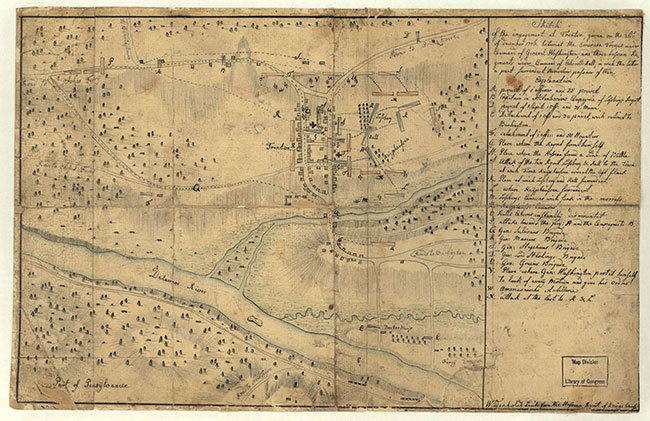
Sketch of the Battle of Trenton by Andreas Wiederholt (b. 1752?). Public domain via Wikimedia Commons.
What’s the one unanswered question about the American Revolution you’d most like answered?
The war in the South in 1780 and 1781 is shot through with mysteries. Why did Benjamin Lincoln stay put in Charleston in 1780? He might have withdrawn to the interior, as did those defending against Burgoyne’s invasion, or he might have made a stand behind the Ashley River — as Washington did on the Brandywine — and then retreated to the interior.
Why in the summer that followed did Horatio Gates immediately take the field when his army was so unprepared and he faced no immediate threat? Why did Gates in August at Camden position his men so that the militia faced Cornwallis’s regulars?
Why in 1781 did not Sir Henry Clinton order General Cornwallis back to the Carolinas or summon him and most of his army to New York?
With all the mistakes, maybe the biggest mystery of the war is how anyone won.
What is your favorite quote by a Revolutionary?
Aside from the egalitarian and natural rights portions of Jefferson’s Declaration of Independence, I have two favorite quotations from revolutionaries. One is that of Captain Levi Preston of Danvers, Massachusetts. When asked why he had soldiered on the first day of the war, he responded: “[W]hat we meant in going for those Redcoats was this: we always had governed ourselves and we always meant to. They didn’t mean we should.” My second favorite is Washington’s remark on learning of Lexington and Concord: a “Brother’s Sword has been sheathed in a Brother’s breast.”
Aside from John and Abigail, what was the best husband-wife duo of the Revolution?
If “best” means the duo that best aided the American Revolution, I am sure there must have been countless nameless men who bore arms while their spouses at home made bullets. But of those with whom I am familiar, I opt for Joseph and Esther Reed. He played an important role in Pennsylvania’s insurgency, served in the army and as Washington’s secretary, played a crucial role in the Continental Army’s escape after the Second Battle of Trenton, sat in the Continental Congress, and was the chief executive of his state for three years. She organized the Ladies Organization in Philadelphia in 1780 and published a broadside urging women not to purchase unnecessary consumer items, but instead to donate the money that they saved to aid the soldiery in the Continental army. Altogether, her campaign raised nearly $50,000 in four states.
What was the most important diplomatic action of the war?
The greatest consequence of the American Revolution stemmed from Jefferson’s master stroke in the Declaration of Independence. His ringing declaration that “all men are created equal” and all possess the natural right to “life, liberty, and the pursuit of happiness” has inspired generations hopeful of realizing the meaning of the American Revolution.
What is your favorite Revolutionary War site (battlefield, home, museum, etc.) to visit today?
If limited to choosing only one site, it would be Mount Vernon. For one thing, George Washington seemed to have a hand in almost everything that occurred in America from 1753 until his death in 1799. In addition, he was a farmer, a pursuit that is alien to most of us today. Mount Vernon includes an informative museum, a functioning distillery and mill, farm land, animals, gardens, and of course the mansion, which opens a window onto the life of a wealthy Virginia planter. Those who lived there as slaves are not overlooked and slavery at Mount Vernon is not whitewashed. Nearly a full day is required to take in everything and at day’s end a visitor who comes without much understanding of the man and his time will leave having received a decent and illuminating introduction to Washington and eighteenth century life and culture.
Propaganda was important during the Revolution. What is your favorite propaganda item?
Had there been an Abraham Zapruder armed with a motion picture camera on Lexington Green on 19 April 1775, we might know precisely what occurred when the first shot was fired in the Revolutionary War. But we will never know if that shot was fired accidentally, whether it was fired by British soldiers following orders, or as some alleged if it was fired by a colonist in hiding. What is known is that soon after that historic day the Massachusetts Committee of Safety deposed witnesses of the bloody event, from which it cobbled together an account showing that the regulars opened fire after being commanded to “Fire, by God, Fire.” That account circulated before the official British report was published. In a day when knowledge of who fired the first shot to launch a war was still important, the Massachusetts radicals had scored a propaganda master stroke.
If you could time travel and visit any American city, colony, or state for one year between 1763 and 1783, which would you choose?
I would choose to be living in Boston in 1763. I would like to know what people in the city were thinking about Anglo-America prior to the Sugar and Stamp Acts and how many had ever heard of The Independent Whig. I would like to visit grog shops to discover whether there was a hint of rebellion among the workers and whether they thought Samuel Adams would ever amount to anything. While there, perhaps I could catch a game at Fenway when the St. Louis Browns come to town.
In your opinion, what was George Washington’s biggest blunder of the war?
A book about Washington’s blunders would be large, but his most baffling mistake occurred in September and October 1776. Although fully aware that he was soon to be trapped in Harlem Heights by a superior British army and utterly dominant Royal Navy, Washington made no attempt to escape his snare. His letters at the time indicate an awareness of his dilemma. They also suggest that in addition to his customary indecisiveness, Washington was not just thoroughly exhausted, but in the throes of a black depression. These assorted factors likely explain his potentially fatal torpor. He and the American cause were saved from the looming disaster by the arrival of General Charles Lee, whose advice Washington still respected. Lee took one look and urged Washington to get the army out of the trap. Washington listened, and escaped.
In your opinion, who was the most overrated revolutionary?
Franklin is the most overrated. He was not unimportant – indeed, I think he was a very great man – but as he was abroad for years, he played a minor role in the insurgency between 1765 and 1775. Furthermore, while Franklin was popular in France, Vergennes was a realist who acted in the interest of his country. It is ludicrous to think that Franklin pulled his strings.
Who was the most underrated revolutionary?
General Nathanael Greene is so underrated that many today are unaware of him. But he was the general that Washington turned to for good advice, made personal sacrifices to try to straighten out the quartermaster corps, and waged an absolutely brilliant campaign in the Carolinas between January and March 1781. It was his heroics in the South that helped drive Cornwallis to take his fateful step into Virginia, and to his doom. Had it not been for Greene, it is difficult to envision a pivotal allied victory on the scale of Yorktown in 1781, and without Yorktown the war would have had a different ending, possibly one that did not include American independence.
Was American independence inevitable?
Chatham and Burke knew how independence could be avoided, but it involved surrendering much of Parliament’s power over the colonists. Burke also glimpsed the possibility of using proffered concessions to play on the divisions in the Continental Congress, which included many delegates who opposed a break with Britain. Burke’s notion might have worked. But from the beginning the great majority in Parliament thought that in a worst case scenario the use of force would bring the colonists to heel. Given the political realities of the day, war appears to have been virtually inevitable. Even so, independence very likely would have been prevented had Britain had an adequate number of troops in America in April 1775 or a capable general to lead the campaign for New York in 1776, someone like Earl Cornwallis.
A version of this Q&A first appeared on the Journal of the American Revolution.
John Ferling is Professor Emeritus of History at the University of West Georgia. He is a leading authority on late 18th and early 19th century American history. His latest book, Jefferson and Hamilton: The Rivalry that Forged a Nation, was published in October 2013. He is the author of many books, including Independence, The Ascent of George Washington, Adams vs. Jefferson: The Tumultuous Election of 1800, Almost a Miracle: The American Victory in the War of Independence, Setting the World Ablaze: Washington, Adams, Jefferson, and the American Revolution, John Adams: A Life, and A Leap in the Dark: The Struggle to Create the American Republic. He lives in Atlanta, Georgia.
Subscribe to the OUPblog via email or RSS.
Subscribe to only American history articles on the OUPblog via email or RSS.
Subscribe to only history articles on the OUPblog via email or RSS.
The post A Q&A with John Ferling on the American Revolution appeared first on OUPblog.


By:
Paula Pertile,
on 7/8/2014
Blog:
Drawing a Fine Line
(
Login to Add to MyJacketFlap)
JacketFlap tags:
cleaning art with Photoshop,
fife and drum,
children's book illustration,
Revolutionary War,
colored pencils,
Prismacolors,
4th of July,
Stars and stripes,
red white and blue,
Add a tag
(click the image to see it larger)
I'm really happy with how these little guys turned out. They were super fun to draw, and I loved using my Prismacolors again for a whole, entire illustration. (Thank you Bostitch Super Pro 6 pencil sharpener for making that possible!)
This guy is very proud to be first in line in the procession, and has been practicing his fife music
a lot, making sure he was ready for today.
This guy lost his nice tricorn hat in a horse-and-wagon mishap just before he had to step into line here, but is trying to put on a brave face, and is very proud that he gets to be the one carrying the flag.
And this guy has been driving his family
nuts, practicing the drums, but they all know its worth it when they see him marching and drumming so well with his friends.
I did this whole thing with colored pencils. And I managed to keep it pretty clean. But even so, it needed a little tweak with Photoshop at the end to look even better. So I thought I'd show you a little 'behind the scenes' look at how things magically get cleaned up before going to print.
This is how it looked straight from the scanner. Its a little 'dirty', and the scanner made a dark edge on the left. Its also a little crooked.
Then here it is cleaned up, and straightened out.
Here's a close up showing one little piece, with the background as it was, then cleaned up.
Can you see how grey the background looks on the left, and all the little 'bits of stuff'? That's the paper texture, and little flecks of pencil that, no matter how careful you are, deposit themselves on the paper and refuse to come off. So, with the help of the eraser tool in Photoshop, I painstakingly go around each figure and erase all of that out, leaving a nice clean background.
I also use the clone tool to carefully pick out any little stray flecks of something that may land on the actual image (here, there was a tiny grain of dark color on his nose).
When I'm working on a piece that I know is going to be printed, and make a little goof or stray mark, I find myself going "That's OK, I'll fix it with Photoshop", and keep going. But when you're doing something where the original art is IT, like a commissioned piece, you have to be really really careful, because there is no room for mistakes, and there is no fixing the final art with Photoshop! The piece has to be perfect (no pressure).
I meant to have this done by the 4th, but oh well. The idea only came to me a couple of days ago, so I drew it out, then started rendering, and of course 'life' happened in between there (nothing bad - just stuff). This is a self-promo piece, so it doesn't have a real deadline, so I guess its OK. I'll just be really really early for next year! heh
Anyway - you can see where I'm going with this I think. I'm going back to this style for my children's book work. I used to work like this a lot, then . . . well, I'll spare you a long boring essay about why I shifted gears and started doing more 'fine art' kind of work. The time I've spent refining my colored pencil style will definitely come in handy here, and has not been time wasted.
"Style" is a hard thing to describe. I call this my "round, shapey people" look. Everyone I draw looks very well fed, and I have a sort of architectural way of designing things. Everything fits together "just so". Its tight, and fully rendered, and there's not a hair out of place (unless its on purpose!).
The outfits these guys are wearing are kind of a mash-up of different Revolutionary War and 'fife and drum corps' uniforms. Most are some combination of red, white and blue, and some are fancier than others. I'm not doing powdered wigs, but will give them each their real hair (partly to get some more color in there).
Hope you all have a good 4th of July, if you're here in the States, and celebrate. We have hot dogs and potato salad and apple pie all ready to go. No fireworks though. They're illegal here, but of course that doesn't stop everyone else from doing them (much to my chagrin - they scare all the animals so). I feel very very thankful for the freedom to be able to draw and color pictures like this all day, for a living, and am so grateful for everyone who has fought for our collective freedoms as a nation to sit and color, and do everything else we do as free people!

By: Julia Callaway,
on 6/30/2014
Blog:
OUPblog
(
Login to Add to MyJacketFlap)
JacketFlap tags:
*Featured,
boston national historical park,
Colonial National Historical Park,
Cowpens National Battlefield,
Frances Kennedy,
Guilford Courthouse,
independence national historical park,
Kings Mountain National Military Park,
minute man national historical park,
Saratoga National Historical Park,
The American Revolution,
The American Revolution: A Historical Guidebook,
Valley Forge national historical park,
washington crossing historic park,
Books,
History,
american history,
Revolutionary War,
America,
Add a tag
In 1996, Congress commissioned the National Park Service to compile a list of sites and landmarks that played a part in the American Revolution. From battlefields to encampments, meeting houses to museums, these places offer us a chance to rediscover the remarkable men and women who founded this nation and to recognize the relevance of not just what they did, but where they did it. Frances Kennedy, editor of The American Revolution: A Historical Guidebook, has compiled a list of her favorite places, and why.
1. Minute Man National Historical Park, Concord, Lincoln, and Lexington, Massachusetts
The American Revolution began years before the first battles of the Revolutionary War, fought at Lexington and Concord in April 1775. In 1765 Parliament passed the Stamp Act which imposed taxes on the colonies. After the colonists began protests, the British ordered soldiers to Boston. In April 1775, after the royal governor of Massachusetts learned that colonists were storing military supplies in Concord, he ordered British regulars to march from Boston to seize the supplies. They fired “the shot heard around the world”. Men on both sides were killed in Lexington and Concord; more British soldiers were killed on their march back to Boston by militiamen firing from behind walls and trees. The Historical Park includes the sites of the battles at Lexington Green and at North Bridge in Concord. In July, the Continental Congress named George Washington commander in chief of the Continental Army.
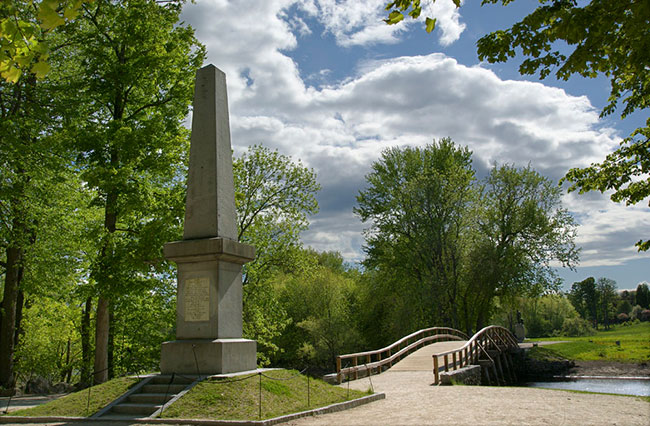
Minute Man National Park, Concord, MA by Jay Sullivan. CC-BY-SA-3.0 via Wikimedia Commons.
2. Boston National Historical Park, Dorchester Heights in South Boston, Massachusetts
In early March 1776, General Washington surprised the British forces occupying Boston by fortifying Dorchester Heights, the hills high above the ships in the harbor. He had received about 60 pieces of the artillery in late February after Colonel Henry Knox, formerly a Boston bookseller, had succeeded in dragging them across more than 200 miles of ice and snow from Fort Ticonderoga on Lake Champlain. Washington’s successful siege forced the British to evacuate Boston. They sailed out of the harbor on March 17 toward New York. The tall white marble monument on the Heights commemorates the siege.
3. Independence National Historical Park, Philadelphia, Pennsylvania
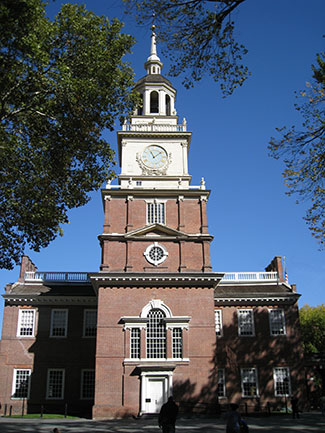
The clocktower at Independence Hall. Philadelphia, PA by Captain Albert E. Theberge, NOAA Corps (ret.) (NOAA Photo Library: amer0024). CC-BY-2.0 via Wikimedia Commons.
Great beginnings in America are commemorated in the Historical Park. In Carpenter’s Hall in 1774, delegates from twelve colonies — all except Georgia – met in the First Continental Congress, to consider how to respond to acts of Parliament that threatened their liberties. The State House of the Province of Pennsylvania, now Independence Hall, was the meeting place for the Second Continental Congress, beginning on May 10, 1775. In 1776, Thomas Jefferson wrote the Declaration of Independence, Congress edited it, and on July 4, Congress accepted it, in the same Hall. After the Articles of Confederation were ratified, the Confederation Congress met in the Hall until June 21, 1783. The Constitutional Convention met in the Hall in May-September 1787 and approved the Constitution on September 17.
4. Washington Crossing Historic Park, Washington Crossing, Pennsylvania
Washington crossed the Delaware River on Christmas night 1776 in a raging snowstorm and on the next day, he won the battle of Trenton, New Jersey. Henry Knox was in command of the crossing, the same officer who had dragged the artillery from Fort Ticonderoga for the successful siege of Boston. Among the men who managed the boats in the dangerous river crossing, amid floating cakes of ice, were the mariners in Colonel John Glover’s Massachusetts regiment, which included blacks, American Indians, and whites. The historic river crossing is commemorated in the two parks, one on each side of the river.
5. Saratoga National Historical Park, Stillwater, New York
In July 1777 General Burgoyne’s 8,000-man British army, which included German soldiers and American Indians, marched down the Hudson River Valley with the goal of splitting the states and isolating New England. Slowed by the dense forests and its long supply line, the army finally crossed the river in mid-September, won a costly victory against the Americans in the battle of Freeman’s Farm, fought another at Bemis Heights on October 7, and was forced by the American siege to surrender 6,800 soldiers on October 17. The Historical Park, along the Hudson River, includes the sites of the battles and the British camp.
6. Valley Forge National Historical Park, King of Prussia, Pennsylvania
The army barely survived the 1977-1978 winter in the Valley Forge camp. More than 2,000 soldiers died as a result of too little to eat and inadequate clothing. Conditions improved in March after Nathanael Greene was appointed quartermaster general. Baron von Steuben, a former Prussian officer commended to Washington by Benjamin Franklin, arrived at the camp in February and began a training regimen for the army. By June 1778 when the soldiers marched out of Valley Forge, they were better trained and more confident. The 5.4 square mile Historical Park includes historic buildings, sites of the brigade encampments, the historic trace road, monuments, and the camp defense lines.
7. Kings Mountain National Military Park, Blacksburg, South Carolina
In the fall of 1780, the patriots known as over-mountain men rode from their farms in Virginia, Tennessee, and North Carolina to battle British Major Patrick Ferguson and his command of loyalists. After riflemen from South Carolina joined the patriots, their force numbered about two thousand. On October 5, they attacked Ferguson’s camp, killed him and one-third of his force and captured about 650 loyalists in the hour-long battle. It was the first major patriot victory after the British capture of Charleston the previous May. The Military Park includes the battle site, monuments, and Ferguson’s grave. The Overmountain Victory National Historic Trail commemorates the patriots’ routes (on today’s maps).
8. Cowpens National Battlefield, Gaffney, South Carolina
Cowpens, a pastureland in South Carolina, is the site of General Daniel Morgan’s attack on Lieutenant Colonel Banastre Tarleton’s British Legion on January 17, 1781. Called a tactical masterpiece, Morgan’s battle plan began with militia sharpshooters who fired two volleys, then fell back behind the Continentals who next attacked, followed by the cavalry. In less than an hour, the British suffered nearly 1,000 casualties, including about 500 captured. Tarleton escaped and rode to General Cornwallis to report the bad news. The 845-acre park includes the battlefield and monuments.
9. Guilford Courthouse National Military Park, Greensboro, North Carolina
In the small community of Guilford Courthouse, General Nathanael Greene used General Morgan’s Cowpens tactics to battle General Cornwallis on March 15, 1781. Cornwallis won the battle over Greene’s militia and Continentals, but his force suffered such heavy casualties that he was left with only about 1,500 soldiers able to fight. He retreated to the coast and made his decision to march north to join the British force in Virginia. The Military Park includes the battlefield and monuments.
10. Colonial National Historical Park, Yorktown, Virginia
In May 1781, General Cornwallis took command of the British soldiers in Virginia and waited for reinforcements to arrive from General Henry Clinton in New York. In mid-August, General Washington and the Comte de Rochambeau, in command of the French army in America, began their march south after learning that the French fleet was sailing for the Chesapeake Bay. On September 5 the French defeated the British fleet in a battle in the Atlantic Ocean off the Bay. Cornwallis could not be reinforced. By September 26 the American and French armies had arrived at Yorktown with about 18,000 soldiers and put Cornwallis’s 5,500-man force under siege. On October 19, Cornwallis surrendered, ending the last major battle of the Revolutionary War. The Historical Park includes Historic Jamestowne in Jamestown and the Yorktown Battlefield in Yorktown. The Washington-Rochambeau Revolutionary Route National Historic Trail commemorates the route (on today’s maps) taken by the two armies, the French from Rhode Island and both south from New York.
Frances H. Kennedy is a conservationist and historian. Her books include The Civil War Battlefield Guide, American Indian Places, and, most recently, The American Revolution: A Historical Guidebook.
Subscribe to the OUPblog via email or RSS.
Subscribe to only American history articles on the OUPblog via email or RSS.
The post The top 10 historic places from the American Revolution appeared first on OUPblog.

By:
KidLitReviews,
on 9/17/2013
Blog:
Kid Lit Reviews
(
Login to Add to MyJacketFlap)
JacketFlap tags:
1776,
5stars,
Library Donated Books,
vanita books,
General William Howe,
Joe Rossi,
Lynda Durrant,
Children's Books,
Historical Fiction,
Favorites,
Revolutionary War,
chapter books,
children's book reviews,
George Washington,
early reader,
Add a tag
. Ariel Bradley, Spy for General Washington By Lynda Durrant Joe Rossi, illustrator Vanita Books 5 Stars . Press Release: Based on a true event. The real life adventures of nine-year-old Ariel Bradley, reveals the anxieties of the Americans who needed desperately to win the battle in the first months of the Revolutionary War. It …
Ok, I'basically had 1 day to do this last drawing since we're leaving on a family trip tomorrow and my son's going to turn his project in before we leave. Soooooo, rather than redrawing the original sketchbook drawing, I just went over it in ink with very few adjustments. Therefore, I'm now noticing an issue with the position of his legs and foot - not quite right. But oh well...

Do I still have my pouch of ammunition and gunpowder? Yes, I do!
One thing that I'll take away from this little mini-commission is the importance of time management. I need to expect to do multiple drawings for a single illustration - in some cases, probably lots! But, this was fun - hope I get an "A."
Now, it's off to Disneyland. I plan to take the sketchbook as we'll have to take turns waiting with the baby for some of the rides - I'm guessing she won't make the height requirement for Space Mountain.
Illustration #4, again, would be a decent 1st draft. I like the proportions of the foreground figure (for the most part). But, there are several things that I would adjust if I had time to do it again.

He got up to the shed and almost screamed as he almost walked right into the path of an armed guard. But, he realized the guard was asleep.
As I'm rapidly running out of time - we leave for Disneyland tomorrow afternoon - I'm working even more quickly and letting things go that I normally might spend more time on. But, I still have one more drawing to do, laundry to put away, suitcases to pack, dogs to bathe...
I managed to knock out a couple more illustrations over the last couple days AND still get some dishes done.
#2 was a quick one since it's a distance shot - little detail to worry about. I wish I hadn't used the thicker pen in the background trees, creating that darker line. Should've just stuck with a thin line, atmospheric value. Oh well...

One day on the farm, when Jake and his brother were plowing the fields...
#3 there are aspects of this that I really like, however the proportion thing is still a bit of a struggle. The table is too short and so the soldier looks at bit cramped under it. Also, the boy is a bit too young looking - proportions seem to work BUT they fit a younger age than I intended.

The recruiter was a Colonial Regular and had obviously been in many battles for he had scars on his face and a bandage around his head.
I actually have one more almost completely done - just not photographed. One more to go. I'm getting a little less meticulous as I really only have one or two more days to work on them. Wish I had time to add a watercolor wash!
Well, Ok...my son asked me to do some illustrations for a short story he did for his English class.
My first thought was "No - it's your project." But, I talked to the teacher who said students were allowed to have outside help on the illustrations. And, my son has always been the type who would rather have dental work done than do anything arts/crafts.
So, I thought it would be a good learning moment for me - translating text into 5 illos. Now, I have less than a week to do it (and I still have to be a mom and homeschool teacher), so they won't be the quality I'd send into a publisher. But, it's still good practice nonetheless.

The story is about the Revolutionary War. So, these are some sketches I've done, just practicing figures and costumes. Luckily, I have LOTS of books about this period in history among all my homeschool resources. A couple of figures are pretty close copies to some in a Revolutionary War coloring book (disclaimer in case you recognize them). Of course, I won't be using those figures - the rather stiff-looking General (above) I copied for warm-up and for the uniform. The woman (below) I used for the pose (her face and hair are different, and she was holding a long canon ramrod in the original - not waving). Hmmm, now that I see her on the screen, her head looks too small for her body - YIKES!

Anyway, this is a rather serious story so I'm trying not to make the figures too "kiddy cartoony" - that's my goal anyway.
I've posted several times in the past on picture books about the American Revolution (Selene Castrovilla's
By the Sword and Upon Secrecy, Anne Rockwell's
They Called Her Molly Pitcher, and several versions of Henry Wadsworth Longfellow's
The Midnight Ride of Paul Revere). And yet, I continue to get requests for more!
New Jersey teachers, especially, have a keen interest in this topic, and not just because it's required in the Core Content Curriculum standards. New Jersey is known as the Garden State, but ask any 4th grader in the state for a second claim to fame, and they'll tell you that New Jersey is also called
The Crossroads of the Revolution. Situated between the strategic colonial cities of New York and Philadelphia, New Jersey witnessed over 100 battles during the War for Independence, as many battles as all other colonies combined.
Lynne Cheney's
When Washington Crossed the Delaware: A Wintertime Story for Young Patriots tells how an event in Trenton, New Jersey would later be called a turning point in the War for Independenc. Readers are provided just enough historical context to set the scene for Washington’s bold attack on Trenton. With his army depleted to just ten percent of its original strength and half his troops’ enlistments about to expire, General George Washington is desperate for a victory. The hope of the new nation rests upon an impossible winter attack on an intimidating foe who has already crushed the Americans in New York and chased them across New Jersey and the Delaware River itself. The rich text and saturated illustrations recount the battles of Trenton as well as Princeton, and accurately depict the resounding effect that these two victories had upon the morale of the Continental Army. Cheney's book is filled not only with beautiful illustrations, but also with numerous quotations from those who lived the events described within the book's covers.
A great extension for this book? Let students pretend that they're colonial soldiers under Washington's command and have them write letters "home" explaining why they're continuing to fight. (An interesting note: following the Batlle of Trenton, the majority of enlistments in Washington's army were up. When the soldiers were promised additional pay, not one stepped forward. Washington then appealed to their loyalty to a noble cause, and then, and only then, because of their trust in and respect for their general, did the men step forward).
1 Comments on Crossroads of the Revolution, last added: 2/22/2010




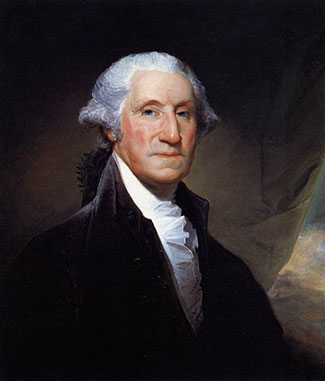
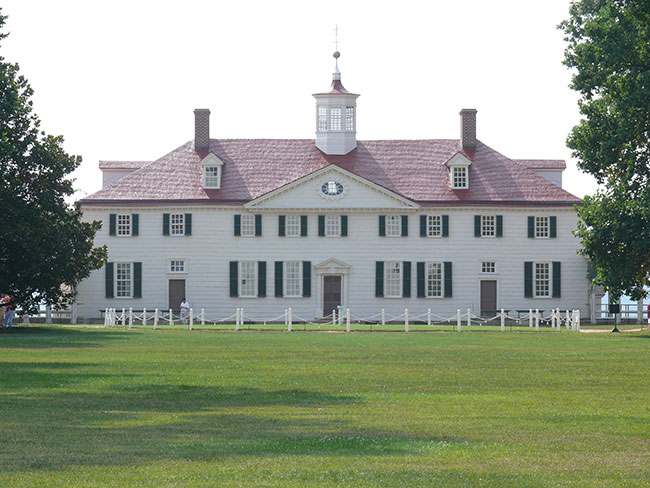










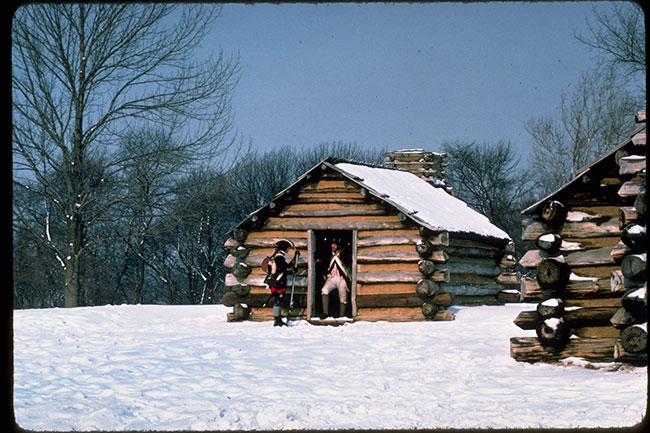
















I read the Scarlett Stockings Spy when I teach the Revolutionary War. It also works wonders to help teach figurative langauge devices such as onomotapoeia, similes, and metaphors. What a good story. I'll have to check out a few of the other ones. I love teaching history!